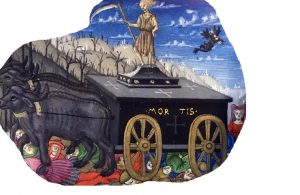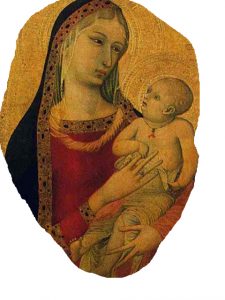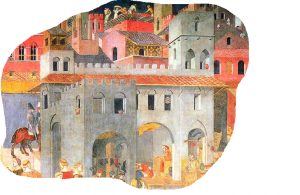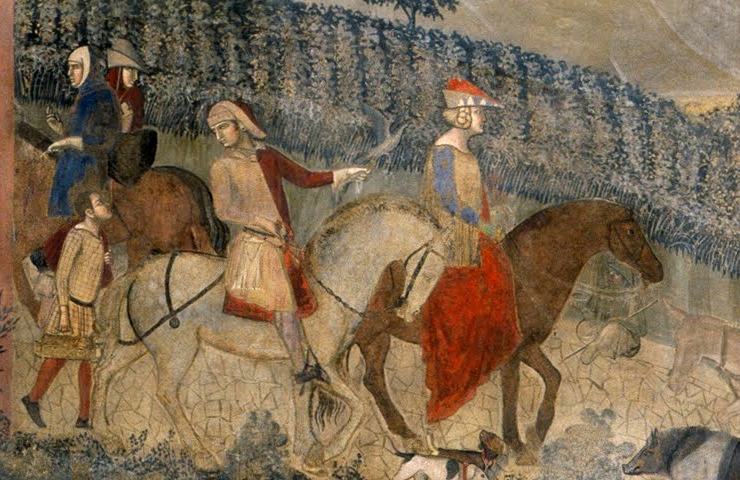A profound humanity, within complex allegories



 Widespread in Europe since 1346, the great lawn mower commonly known as the other death or black plague https://www.ilpalio.org/gabrielli_pesteigine.htm had claimed over twenty million human lives before disappearing. In 1348, due to that epidemic and just like his brother, a man named Ambrogio also died in Siena. Fearing the imminence of his death, in one of his wills dated 9 June, in fact, he arranged that his possessions for the Company of the Virgin Mary.
Widespread in Europe since 1346, the great lawn mower commonly known as the other death or black plague https://www.ilpalio.org/gabrielli_pesteigine.htm had claimed over twenty million human lives before disappearing. In 1348, due to that epidemic and just like his brother, a man named Ambrogio also died in Siena. Fearing the imminence of his death, in one of his wills dated 9 June, in fact, he arranged that his possessions for the Company of the Virgin Mary.



 One of his “Madonna and Child” https://pinacotecabrera.org/collezione-online/opere/madonna-con-il-bambino-8/, tempera and gold on wood made by Ambrogio Lorenzetti around 1320-1330, is kept in the Pinacoteca of Brera, in Milan. Inside the Uffizi Gallery in Florence and coming from the town church of San Procolo, the “Triptych of San Procolo” is preserved one of his tempera and gold on wood of 1332http://www.opificiodellepietredure.it/index.php?it/1233/ambrogio-lorenzetti-trittico-of-san-procolo-florence-galleries-of-the-uffizi.
One of his “Madonna and Child” https://pinacotecabrera.org/collezione-online/opere/madonna-con-il-bambino-8/, tempera and gold on wood made by Ambrogio Lorenzetti around 1320-1330, is kept in the Pinacoteca of Brera, in Milan. Inside the Uffizi Gallery in Florence and coming from the town church of San Procolo, the “Triptych of San Procolo” is preserved one of his tempera and gold on wood of 1332http://www.opificiodellepietredure.it/index.php?it/1233/ambrogio-lorenzetti-trittico-of-san-procolo-florence-galleries-of-the-uffizi.



 Born in the city of Siena in 1285, Ambrogio Lorenzetti underwent the pictorial influence of his brother Pietro, creating human figures who assumed loose and balanced postures, with a very personal realistic individualism that paid attention to composition and form of the fourteenth century http://www.travelingintuscany.com/arte/arte/sieneseschool.htm. He distinguished himself for the allegorical component of his works, within which you can clearly distinguish the humanity of the subjects he represents. According to a document dated 1321, it seems that he has contracted a debt towards a certain Meo di Lapo. In this regard, is also documented that he bought a house in Siena in 1324, but that he had to sell one of his landed properties.
Born in the city of Siena in 1285, Ambrogio Lorenzetti underwent the pictorial influence of his brother Pietro, creating human figures who assumed loose and balanced postures, with a very personal realistic individualism that paid attention to composition and form of the fourteenth century http://www.travelingintuscany.com/arte/arte/sieneseschool.htm. He distinguished himself for the allegorical component of his works, within which you can clearly distinguish the humanity of the subjects he represents. According to a document dated 1321, it seems that he has contracted a debt towards a certain Meo di Lapo. In this regard, is also documented that he bought a house in Siena in 1324, but that he had to sell one of his landed properties.

 In 1328-1330, he enrolled in the Art of Medici and Apothecaries, including painters. In Asciano, visiting the Palazzo Corboli Archaeological and Sacred Art Civic Museum, you can admire the extraordinary work of an innovative artist. It is “Altarpiece with the Virgin and Child, St. Michael the Archangel and Saints Bartolomeo and Benedetto”, a tempera and gold on wood, http://www.cretesenesi.com/img_news/tritticobadiarofeno.pdf, created by Ambrogio Lorenzetti when he was approaching fifty years of age, for the Badia dei Santi Giacomo e Cristoforo in Rofeno.
In 1328-1330, he enrolled in the Art of Medici and Apothecaries, including painters. In Asciano, visiting the Palazzo Corboli Archaeological and Sacred Art Civic Museum, you can admire the extraordinary work of an innovative artist. It is “Altarpiece with the Virgin and Child, St. Michael the Archangel and Saints Bartolomeo and Benedetto”, a tempera and gold on wood, http://www.cretesenesi.com/img_news/tritticobadiarofeno.pdf, created by Ambrogio Lorenzetti when he was approaching fifty years of age, for the Badia dei Santi Giacomo e Cristoforo in Rofeno.

 In the heart of Tuscany, between Florence and Siena, in 1319 Ambrogio Lorenzetti created and signed a “Madonna and Child” in the church of Sant’Angelo Vico l’Abate instead. With a single rectangular nave and a facade with a Renaissance portal, that church dating back to the 12th century and rebuilt in 1539 has preserved that image, preserved in the Giuliano Ghelli Museum in San Casciano https://corrierefiorentino.corriere.it/firenze/notizie/arte_e_cultura/17_october_16/blue-madonna-lorenzetti-17c509b0-b2aa-11e7-bd36-5b34f2a71086.shtml
In the heart of Tuscany, between Florence and Siena, in 1319 Ambrogio Lorenzetti created and signed a “Madonna and Child” in the church of Sant’Angelo Vico l’Abate instead. With a single rectangular nave and a facade with a Renaissance portal, that church dating back to the 12th century and rebuilt in 1539 has preserved that image, preserved in the Giuliano Ghelli Museum in San Casciano https://corrierefiorentino.corriere.it/firenze/notizie/arte_e_cultura/17_october_16/blue-madonna-lorenzetti-17c509b0-b2aa-11e7-bd36-5b34f2a71086.shtml

 San Casciano was a strategic military outpost with solid walls seven meters high, equipped with two main gates oriented in the direction of Florence and Siena. Right here, in the Giuliano Ghelli Museum https://www.sancascianovp.net/museo-san-casciano, you can admire the beauty of the child’s hand and the blue color of that Madonna, a beautiful shade created when the painter Ambrogio Lorenzetti was 29 years old. As for the evolution of the pictorial style, starting from his youthful works, his characters show extreme naturalism.
San Casciano was a strategic military outpost with solid walls seven meters high, equipped with two main gates oriented in the direction of Florence and Siena. Right here, in the Giuliano Ghelli Museum https://www.sancascianovp.net/museo-san-casciano, you can admire the beauty of the child’s hand and the blue color of that Madonna, a beautiful shade created when the painter Ambrogio Lorenzetti was 29 years old. As for the evolution of the pictorial style, starting from his youthful works, his characters show extreme naturalism.

 Around 1332, the year in which Ambrogio Lorenzetti visited Florence, as evidence of his activity in that city, the Sienese painter had painted scenes from the legend of San Nicola di Bari in an altarpiece, developing narrative skills that favored architecturally harmonious orchestrations. When visiting Florence, do not forget that its Uffizi Museum hosts “The miracle of the grain ships” https://www.uffizi.it/opere/lorenzetti-nicola-storie2, tempera on wood with a gold background restored in 2017.
Around 1332, the year in which Ambrogio Lorenzetti visited Florence, as evidence of his activity in that city, the Sienese painter had painted scenes from the legend of San Nicola di Bari in an altarpiece, developing narrative skills that favored architecturally harmonious orchestrations. When visiting Florence, do not forget that its Uffizi Museum hosts “The miracle of the grain ships” https://www.uffizi.it/opere/lorenzetti-nicola-storie2, tempera on wood with a gold background restored in 2017.

 In the interactions that you can observe in the scenes he painted, you can easily identify a complex allegorical web impregnated with the humanity of the protagonists. A “Majesty”, which Ambrogio Lorenzetti had made in 1335 for the church of San Pietro all’Orto, is a 155X206 cm painting in tempera and gold on a panel. Traces of this admirable work, currently preserved in the Museum of Sacred Art of Massa Marittima, were lost until it has been found in a church, http://www.travelingintuscany.com/arte/ambrogiolorenzetti/maestadimassamarittima.htm.
In the interactions that you can observe in the scenes he painted, you can easily identify a complex allegorical web impregnated with the humanity of the protagonists. A “Majesty”, which Ambrogio Lorenzetti had made in 1335 for the church of San Pietro all’Orto, is a 155X206 cm painting in tempera and gold on a panel. Traces of this admirable work, currently preserved in the Museum of Sacred Art of Massa Marittima, were lost until it has been found in a church, http://www.travelingintuscany.com/arte/ambrogiolorenzetti/maestadimassamarittima.htm.

 He returned to Siena in 1335, where with attention to detail and skill in the use of aerial perspective Ambrogio Lorenzetti in the two-year period 1337-1339 had frescoed one of the most beautiful and significant fresco cycles of the Middle Ages. Inside a large hall of the city public palace http://www.sienaguidavirtuale.it/accessible/ita/geo_palazzopubblico_introduction.html, the Sala Della Pace, this profane pictorial cycle develops with meticulous determination the values and the Sienese atmospheres of those years.
He returned to Siena in 1335, where with attention to detail and skill in the use of aerial perspective Ambrogio Lorenzetti in the two-year period 1337-1339 had frescoed one of the most beautiful and significant fresco cycles of the Middle Ages. Inside a large hall of the city public palace http://www.sienaguidavirtuale.it/accessible/ita/geo_palazzopubblico_introduction.html, the Sala Della Pace, this profane pictorial cycle develops with meticulous determination the values and the Sienese atmospheres of those years.

 At the Abbey of San Galgano, where on the wall of the entrance door you will see a representation of San Galgano in the act of giving the Sword in the Rock to San Michele Arcangelo. Ambrogio Lorenzetti frescoed the chapel of the Hermitage of Montesiepi in 1336 http://www.sangalgano.info/cappella_it.html, with well-restored frescoes in 2020 representing respectively “the Majesty with child” and “the Annunciation with the Archangel Gabriel”.
At the Abbey of San Galgano, where on the wall of the entrance door you will see a representation of San Galgano in the act of giving the Sword in the Rock to San Michele Arcangelo. Ambrogio Lorenzetti frescoed the chapel of the Hermitage of Montesiepi in 1336 http://www.sangalgano.info/cappella_it.html, with well-restored frescoes in 2020 representing respectively “the Majesty with child” and “the Annunciation with the Archangel Gabriel”.

 In the church of the Convent of Sant’Agostino di Siena, https://www.museionline.info/tipologie-museo/chiesa-di-sant-agostino-siena, begun to build in 1258 and continued for half a century, Ambrogio Lorenzetti painted in 1337 “The Majesty” of the Piccolomini Chapel. The fresco, with the faces of the figures that reveal the typical features of his pictorial style, measuring 128 × 240 cm and was accidentally discovered in 1944.
In the church of the Convent of Sant’Agostino di Siena, https://www.museionline.info/tipologie-museo/chiesa-di-sant-agostino-siena, begun to build in 1258 and continued for half a century, Ambrogio Lorenzetti painted in 1337 “The Majesty” of the Piccolomini Chapel. The fresco, with the faces of the figures that reveal the typical features of his pictorial style, measuring 128 × 240 cm and was accidentally discovered in 1944.

 Coming from the Duomo of Siena, but currently kept in room number three of the Uffizi Gallery in Florence, “the Presentation in the Temple” https://www.uffizi.it/opere/presiliazione-al-tempio, is a tempera painting on wood. Extraordinarily rich in details and inspired by everyday life, Ambrogio Lorenzetti it signed and dated in 1342, generously painting the sensation of depth even with the converging joints of the polychrome marbles of the floor.
Coming from the Duomo of Siena, but currently kept in room number three of the Uffizi Gallery in Florence, “the Presentation in the Temple” https://www.uffizi.it/opere/presiliazione-al-tempio, is a tempera painting on wood. Extraordinarily rich in details and inspired by everyday life, Ambrogio Lorenzetti it signed and dated in 1342, generously painting the sensation of depth even with the converging joints of the polychrome marbles of the floor.

 The expressive horizon by Ambrogio Lorenzetti, master of the Sienese school and author of an important cycle of allegorical frescoes, ranged between Massa Marittima and Siena, San Galgano and Florence. It end with a tempera and gold painting on wood preserved in the National Pinacoteca of Siena, “the Annunciation” https://www.artesvelata.it/annunciazione-lorenzetti/, which he made in 1344, four years before he died of the plague. Observing the gestures of Mary, you too can perceive the disturbance of the Madonna at the appearance of the angel.
The expressive horizon by Ambrogio Lorenzetti, master of the Sienese school and author of an important cycle of allegorical frescoes, ranged between Massa Marittima and Siena, San Galgano and Florence. It end with a tempera and gold painting on wood preserved in the National Pinacoteca of Siena, “the Annunciation” https://www.artesvelata.it/annunciazione-lorenzetti/, which he made in 1344, four years before he died of the plague. Observing the gestures of Mary, you too can perceive the disturbance of the Madonna at the appearance of the angel.

 To broaden your horizon of knowledge about other painters, you can type http://meetingbenches.com/category/paintings/. The sole purpose of this site is to spread the knowledge of these artists and that other people enjoy their works. The property of the images that appear in this blog correspond to their authors.
To broaden your horizon of knowledge about other painters, you can type http://meetingbenches.com/category/paintings/. The sole purpose of this site is to spread the knowledge of these artists and that other people enjoy their works. The property of the images that appear in this blog correspond to their authors.







